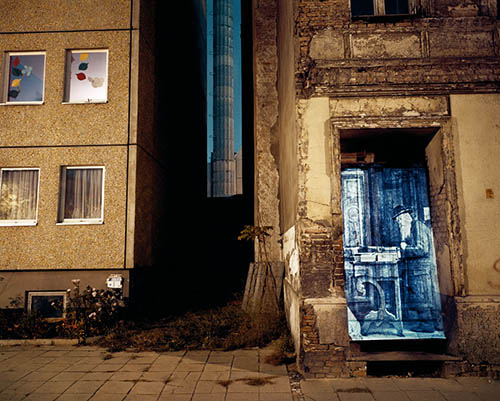Photography and Violence 4: On Memory
1. Shimon Attie’s The Writing on the Wall, 1991-1992
Walking in the streets of the city that summer, I felt myself asking over and over again, Where are all the missing people? What has become of the Jewish culture and community which had once been at home here? I felt the presence of this lost community very strongly, even though so few visible traces of it remained.
— Shimon Attie
In Berlin in 1991, after weeks of research, Shimon Attie projected images from the 1920s and 1930s that belong to a lost Jewish past. These slides were projected onto the same or nearby spaces where the photographs have been taken sixty years earlier. He wanted to confront a city haunted by the absence of its murdered and deported Jews. The Writing on the Wall project was realized in one of Berlin’s former Jewish quarters, the Scheunenviertel, located in the Eastern part of the city, close to the Alexanderplatz. Each installation ran for one or two evenings for the local audience and passersby to see. Attie also photographed the installations themselves in time exposures lasting from three to four minutes. This project is part photography, part installation, and part performance.

Shimon Attie, Almstadtstrasse (formerly Grenadierstrasse)/corner Schendelgasse. Slide projection of former religious book salesman, 1930, Berlin, 1992, color photograph and on-location installation.

Shimon Attie, Joachimstrasse 2. Slide projection of former Jewish residence, ca. 1930, Berlin, 1992, color photograph and on-location installation.

Shimon Attie, Joachimstrasse/corner Auguststrasse: Slide projection of former Jewish resident, 1931, Berlin, 1992, color photograph and on-location installation.
2. Marcelo Brodsky’s Buena Memoria (Good Memory), 1997
In Argentina over 30,000 people were tortured and killed during the Dirty War that started after the military junta, led by Army Commander in Chief Lieutenant General Jorge Rafael Videla, dissolved in 1976 the Argentine Congress. During that period, some 10,000 people “disappeared,” or more precisely, were disappeared, considered a political or ideological threat to the military junta. When Marcelo Brodsky came back to Argentina from exile in 1994, after having lived more than a decade abroad, he tried to locate his old classmates. Taking as his starting point the graduation photograph of the class of 1967 at the Colegio Nacional in Buenos Aires, he found out that 105 of them had disappeared. His installation Good Memory exhibits photographs and video of the intensive research he undertook. It includes a blown-up photograph of his eighth-grade class taken in 1967, in which he has circled 13 out of the 32 figures to indicate friends who, as adults, went into political exile or disappeared. Good Memory also shows the last picture of the artist’s brother, Fernando, before he was taken to a military prison, where he was jailed and murdered, as well as a video that shows a memorial organized by the artist that included a public reading of names of his disappeared schoolmates.
3. Susan Meiselas’ Reframing History, 2004
In July 2004, for the 25th anniversary of the overthrow of Somoza, Meiselas returned to Nicaragua with nineteen mural-sized images of her photographs from 1978-1979, collaborating with local communities to create sites for collective memory. The project, Reframing History, placed murals on public walls and in open spaces in the towns, at the sites where the photographs were originally made. (Source: Susan Meisela’s website.)

Susan Meiselas, Cuesto del Plomo, Managua, from the series, “Reframing History,” 2004. Hillside outside Managua, a well-known site of many assassinations carried out by the National Guard. Original image taken July, 1978.

Susan Meiselas,Residential neighborhood, Matagalpa, from the series “Reframing History,” 2004. Original photo taken August, 1978.



